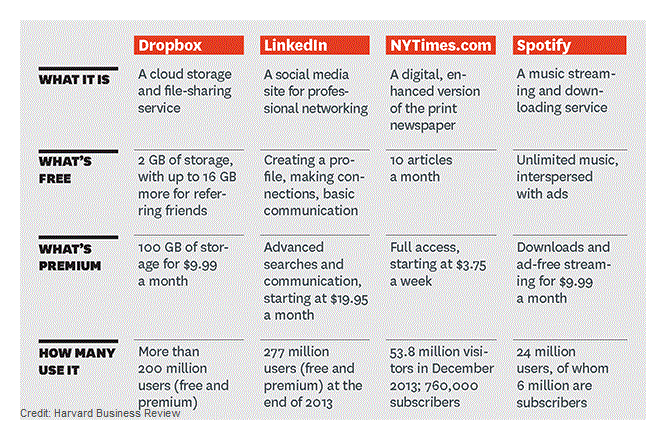Freemium isn't new to 2014, but it certainly is a buzzword this year. This model of doing business shows up a lot in the world of phone apps and online games, but it's grown into a much wider trend. And for good reason - it's smart marketing to give potential customers a taste of what you have to offer for free.

I'm a big believer in freebies and samples in general – read my blog about using freebies for lead generation for a primer. That said, the freemium model isn't without its flaws, and it certainly won't work for everyone. There are users who will dislike freemium services, and many, many more who will use the free part of the service forever without contributing a dime of their own funds to your bottom line. But there are also those hesitant leads who will try out a free service and eventually convert to paying customers, and they're worth some effort.
The Freemium Model
There are many different types of freemium business models. The essence behind all of them is that users will get some level of service or content for free, but have the option to get a higher level of service or better content if they pay.
Related Class: Roadmap to Mobile Marketing: App and Web Strategy
In some popular smartphone games (I personally play a lot of Sudoku), you get the full game but have to put up with ads unless you upgrade to a premium version for ad-free play. Other games allow you to pay for a bonus within the game, like more game lives or virtual goods. This model was thoroughly lambasted on a recent episode of South Park, where players of a Terrance and Phillip mobile game can buy “Canadough” to advance in the game.

But long before we all got addicted to Candy Crush, online businesses were using a similar technique. I am a Spotify success story: I used their free services for months before I got sick of the ads and decided I could afford it. I would never have signed up for a subscription music streaming service normally, but I had come to depend on the free service and it was an easy step up from there.
In both the B2C and B2B worlds, many well-established businesses rely on freemium services to draw in paying customers – Dropbox, LinkedIn, even Google and Apple’s cloud storage follows this model.
The Benefits
I’m going to keep this brief since I think the advantages of freemium services are obvious: it’s an easy way to turn leads into paying customers, since they can try out your services. Because you’re offering them a free service (and not asking for a credit card), you won’t have to do as much marketing and nurturing to take new leads from curiosity to active participation. And even those people who use your service and never pay will likely be telling their friends and co-workers about your business.
The Trouble Spots
Obviously the primary issue with the freemium model is that it simply cannot be stretched to fit most types of businesses. Companies that offer services rather than products are a better natural fit for the model, but that doesn’t mean you can’t bring a freemium aspect to your eCommerce site. An example that works for many online retailers is the Amazon Prime model – every day users have full use of your store and access to your products, but those who subscribe the premium service get perks like free shipping, access to exclusive services, discounts, etc.
Related Class: Marketing Automation Strategy for Full Lifecycle Management
Another natural hazard when offering freemium services is the annoyance factor. Some users will be frustrated with limited features, ads, prompts to upgrade, paywalls, etc. They’ll bail on your service without ever converting to a subscription. There was a significant backlash when the New York Times created a paywall that limits non-subscribers to 10 articles a month, though this is paying off well for the company. My local paper gets angry comments and tweets every day from users who are frustrated with the paywall.
It’s not something to be overlooked; you should weigh carefully the impact that setting up a freemium service will have on your brand as a whole. Is it worth offering freemium features if you’ll tick off current loyal customers? Is the model compatible with your brand’s image and ethos?
The Balance
They key to the above questions is really about getting your balance right – what’s free and what’s not. If you offer too much for free, your conversion rate will be abysmal; if you offer too little, you’ll frustrate users who will never truly commit to your service. The below chart shows how some top businesses strike this balance; it’s from a great Harvard Business Review piece on freemium in practical terms.

Getting pricing right is also key to this equation, and it depends on the perks you’re offering for upgraded users. Remember that premium subscriptions are not your sole source of revenue for the service, so you shouldn’t have to charge steep prices. Ideally you’ll have some sort of ad revenue tied to non-subscription users, to offset their service costs. And then there’s this startling fact: that Harvard Business Review study I mentioned above found that free users are generally worth 15-25% as much as paying subscribers, because of the value they generate in referrals. That’s great marketing and smart business!
So can freemium work for your specific business? That’s something that won’t be answered here, but you should do your homework, study your options and decide for yourself. This isn’t a fluke trend or just the next big thing; it’s a growing market that can work for many smart companies who are willing to have a flexible approach.